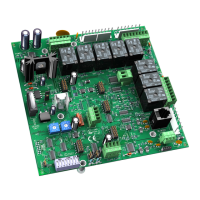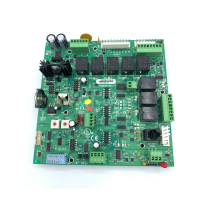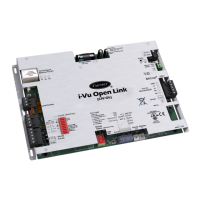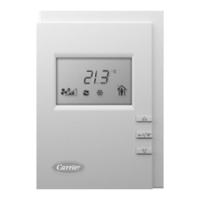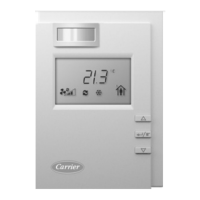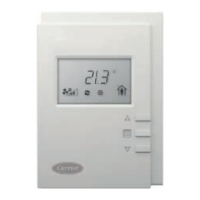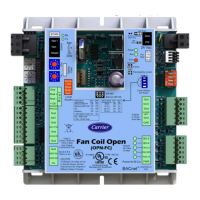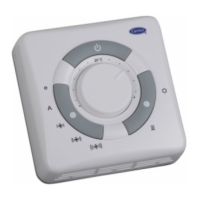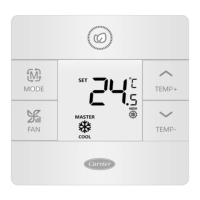Sequence of Operation
RTU Open v3 Carrier Proprietary and Confidential CARRIER CORPORATION ©2016
Integration Guide All rights reserved
28
– This alarm indicates a communication failure of a connected ZS sensor that had previously been
actively communicating. The alarm is reset when normal ZS sensor communications resume, if power is cycled to
the controller, or if the
point is set to
.
– This alarm indicates that at least 1 ZS sensor is configured in the Sensor Binder properties
and is not communicating. The alarm is reset when the configured ZS sensor is communicating or the
configuration is changed to reflect the sensor is no longer connected to the Rnet.
– This alarm indicates an invalid sensor condition in a physically connected space
temperature sensor (SPT Sensor/T5*). Cooling, heating, and supply fan operation stop after the appropriate time
guards. Normal operation resumes when the controller detects a valid sensor.
– This alarm indicates that the supply air temperature is outside the configured alarm
limits. The alarm is reset to normal when the supply air temperature returns within the configured alarm limits
plus a 5
°F (2.7 °C) hysteresis. This alarm is inhibited until the fan has been running for 15 minutes to allow for
system stabilization after startup.
– This alarm indicates a shorted or open circuit in the SAT input. Cooling, heating, and
supply fan operation stops after the appropriate time guards. Normal operation resumes when the controller
detects a valid sensor.
– The RTU Open generates an
alarm if the CO
2
level exceeds the configured
alarm limits. (This alarm is only shown when a valid indoor air quality sensor value is available).
Indoor Air Quality Sensor
– The RTU Open generates an
Indoor Air Quality Sensor
alarm if a valid sensor value is
no longer available. For locally connected sensors, the mA input at the associated channel falls below 3.5 mA or
rises above 21 mA. For network sensors, the controller is no longer receiving a value from the network. Cooling,
heating, and supply fan continue to operate. However, the controller’s IAQ control function is disabled until the
fault condition is corrected.
– The RTU Open generates a
alarm if the space humidity level
exceeds the configured low or high alarm limits. (This alarm is only shown when a valid relative humidity sensor
value is available).
Space Relative Humidity Sensor
– The RTU Open generates a
Space Relative Humidity Sensor
alarm if a valid
sensor value is no longer available. For locally connected sensors, the mA input at the associated channel falls
below 3.5 mA or rises above 21 mA. For network sensors, the controller is no longer receiving a value from the
network. Cooling, heating, and supply fan operation continues, however, the controller’s Humidi-MiZer™ binary
output is disabled until the fault condition is corrected.
– If the RTU Open is configured to monitor the filter through a hardware input switch contact, it generates a
alarm if the associated input channel detects a dirty filter condition (opposite state of the
“x”
). Otherwise, if no hardware switch monitoring is used, the RTU Open generates a filter alarm when
the accumulated runtime exceeds the
>
Filter Service Alarm Timer
value (when not set to 0).
This alarm is most commonly used to indicate a filter replacement is due. Reset the filter service runtime
accumulator by setting the
>
Reset Filter Runtime Alarm
to
, back to
, and clicking
after
each setting. Set
>
Filter Service Alarm Timer
value to
to disable the filter service alarm
function.
– This alarm indicates a shorted or open circuit in the locally connected OAT input.
– This alarm indicates a valid OAT sensor value is no longer available. An alarm
condition can occur from a failed locally connected sensor or if a network OAT value is no longer being received by
the controller. Cooling, heating, and supply fan operation continues. OAT lockouts will not operate while the sensor
is in alarm. Normal operation resumes when the controller detects a valid sensor.
– This alarm is active when an economizer fault is detected, as required by the CEC Title
24 Economizer FDD logic. Once detected, this alarm will stay active until the
input is set to
or the
fan is stopped.
– This point indicates the specific fault detected and announced by the Economizer Operation alarm
above. Detected fault conditions include
,
,
, and
.
